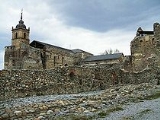
Monastery of Carracedo
Encyclopedia
_-_monasterio_de_santa_maria_06.jpg)
Carracedelo
Carracedelo is a village and municipality located in the region of El Bierzo . According to the 2010 census , the municipality has a population of 3,658 inhabitants. The semirestored ruins of the Monastery of Saint Mary of Carracedo are nearby....
, province of León, Castile and León
Castile and León
Castile and León is an autonomous community in north-western Spain. It was so constituted in 1983 and it comprises the historical regions of León and Old Castile...
, Spain
Spain
Spain , officially the Kingdom of Spain languages]] under the European Charter for Regional or Minority Languages. In each of these, Spain's official name is as follows:;;;;;;), is a country and member state of the European Union located in southwestern Europe on the Iberian Peninsula...
. Founded in the tenth century by the Benedictine order, it lies near the Way of Santiago in Northern Spain.
The first cenobitic community, the Monastery of San Salvador, was founded here around the year 990 by Bermudo II
Bermudo II of León
Bermudo II , called the Gouty , was the King of Galicia and León . His reign is summed up by Justo Pérez de Urbel's description of him as "el pobre rey atormentado en la vida por la espada de Almanzor y en muerte por la pluma vengadora de un obispo" Bermudo (or Vermudo) II (956–999), called the...
, King of the Kingdom of León
Kingdom of León
The Kingdom of León was an independent kingdom situated in the northwest region of the Iberian Peninsula. It was founded in AD 910 when the Christian princes of Asturias along the northern coast of the peninsula shifted their capital from Oviedo to the city of León...
and the Kingdom of Galicia
Kingdom of Galicia
The Kingdom of Galicia was a political entity located in southwestern Europe, which at its territorial zenith occupied the entire northwest of the Iberian Peninsula. Founded by Suebic king Hermeric in the year 409, the Galician capital was established in Braga, being the first kingdom which...
, with the principal aim of sheltering monks seeking refuge from the campaigns of the Moor
Moors
The description Moors has referred to several historic and modern populations of the Maghreb region who are predominately of Berber and Arab descent. They came to conquer and rule the Iberian Peninsula for nearly 800 years. At that time they were Muslim, although earlier the people had followed...
ish general Almanzor. This, however, did not spare the monastery from being destroyed by Almanzor in his campaign of 997.
In 1138, the Infanta Sancha, sister of Alfonso VII of León and Castile, helped rebuild a monastery on the site, calling on monks from the neighboring Monastery of Santa María de Valverde near Corullón
Corullón
Corullón is a village and municipality located in the region of El Bierzo . According to the 2010 census , the municipality has a population of 1,122 inhabitants....
, to help her. The burgeoning monastery gained eminence, and control of lands, and also housed a royal palace. In 1203, the monastic order switched to the Cistercian order, affiliated with the Cîteaux
Cîteaux Abbey
Cîteaux Abbey is a Roman Catholic abbey located in Saint-Nicolas-lès-Cîteaux, south of Dijon, France. Today it belongs to the Trappists, or Cistercians of the Strict Observance . The Cistercian order takes its name from this mother house of Cîteaux, earlier Cisteaux, near Nuits-Saint-Georges...
, also calling itself the Monasterio de Santa María de Carracedo. Undergoing further depredations during the Napoleonic wars, the abbey was closed in 1835.
The monastery is listed on the Spanish heritage register as a Bien de Interés Cultural
Bien de Interés Cultural
A Bien de Interés Cultural is a category of the Spanish heritage register. This category dates from 1985 when it replaced the former heritage category of Monumento nacional in order to extend protection to a wider range of cultural property...
(BIC), having been declared a National Historic-Artistic Monument in 1929. The now uninhabited rooms and cloister of the semi-restored ruins exemplify a variety of styles from the centuries between the foundation and abandonment, contain a variety of styles including Romanesque
Romanesque architecture
Romanesque architecture is an architectural style of Medieval Europe characterised by semi-circular arches. There is no consensus for the beginning date of the Romanesque architecture, with proposals ranging from the 6th to the 10th century. It developed in the 12th century into the Gothic style,...
, Gothic
Gothic architecture
Gothic architecture is a style of architecture that flourished during the high and late medieval period. It evolved from Romanesque architecture and was succeeded by Renaissance architecture....
, and neoclassical
Neoclassical architecture
Neoclassical architecture was an architectural style produced by the neoclassical movement that began in the mid-18th century, manifested both in its details as a reaction against the Rococo style of naturalistic ornament, and in its architectural formulas as an outgrowth of some classicizing...
. The sparingly-decorated stony buildings have a haunting emptiness.
_-_monasterio_de_santa_maria_05.jpg)
_-_monasterio_de_santa_maria_14.jpg)
External links
- Translated from Spanish Wikipedia entry

